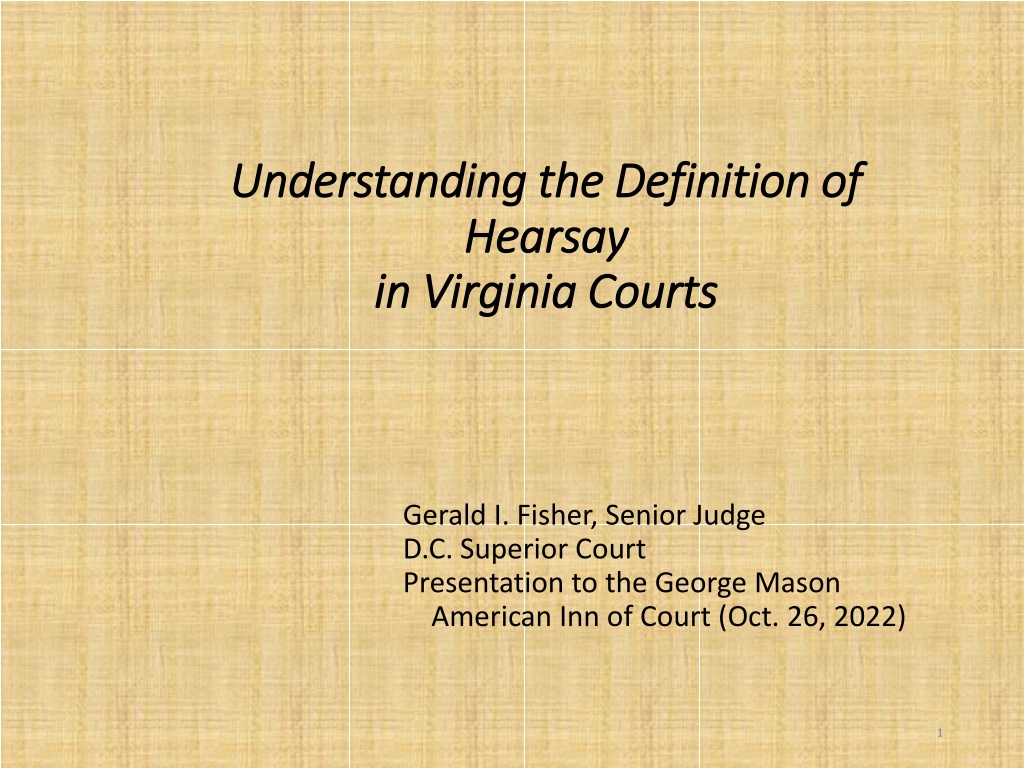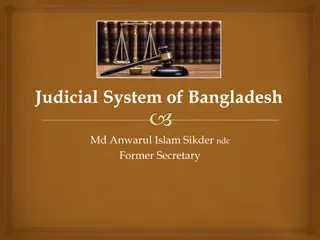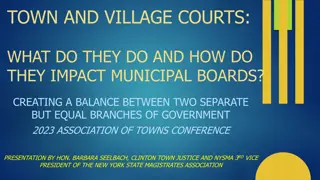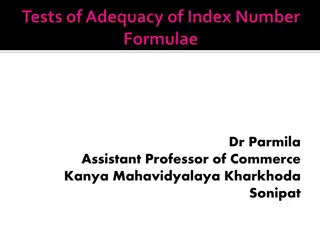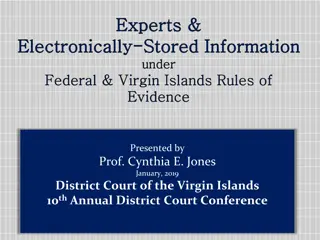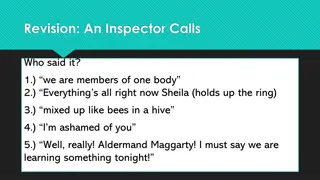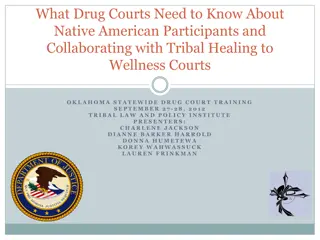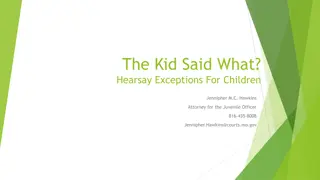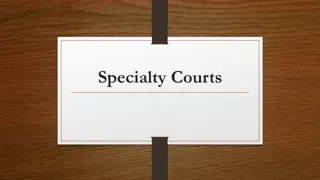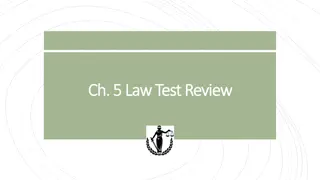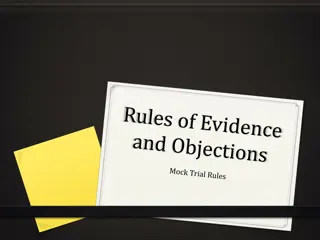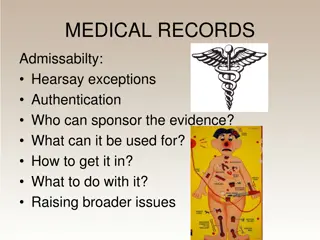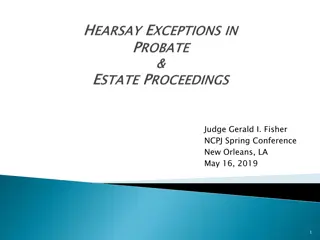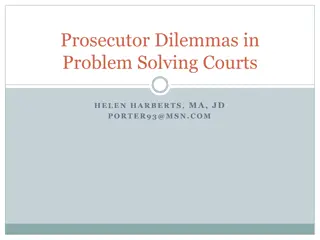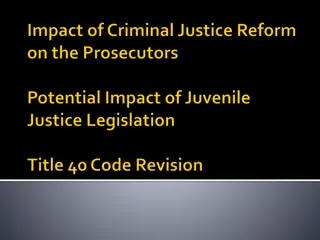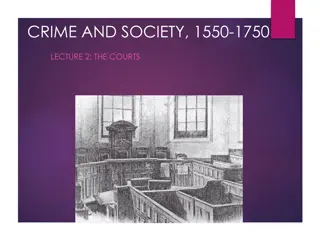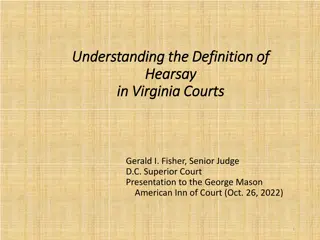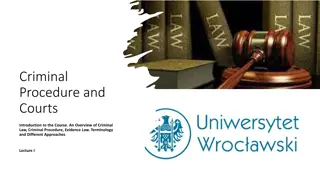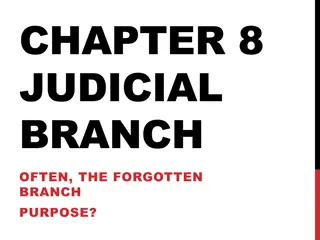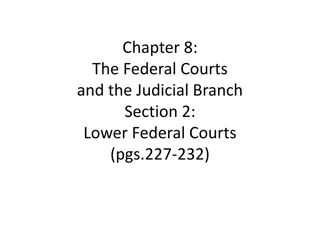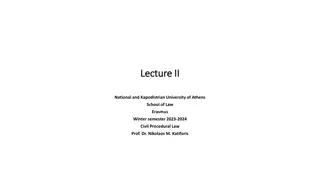Understanding the Definition of Hearsay in Virginia Courts by Gerald I. Fisher, Senior Judge
Preliminary principles and rules regarding hearsay in Virginia courts, including the effective date of the Virginia Rules of Evidence, application of rules in various trial scenarios, criteria for admissibility of evidence by trial judges, and reasons for the legal distrust of hearsay evidence. The presentation explores the definition of hearsay and provides insights into the decision-making process by trial judges.
Download Presentation

Please find below an Image/Link to download the presentation.
The content on the website is provided AS IS for your information and personal use only. It may not be sold, licensed, or shared on other websites without obtaining consent from the author. Download presentation by click this link. If you encounter any issues during the download, it is possible that the publisher has removed the file from their server.
E N D
Presentation Transcript
Understanding the Understanding the Definition of Hearsay Hearsay in Virginia Courts in Virginia Courts Definition of Gerald I. Fisher, Senior Judge D.C. Superior Court Presentation to the George Mason American Inn of Court (Oct. 26, 2022) 1
Preliminary Principles 1. The Virginia Rules of Evidence became effective July 1, 2012. [A]dopted to implement established principles under the common law and not to change any established case law rendered prior to the adoption of the Rules. Rule 2:102. Rejected adoption of the Federal Rules of Evidence 2. The Rules, including the rules relating to hearsay, apply in both jury and non-jury trials, in preliminary hearings, in non-summary contempt cases, and in juvenile and domestic relations cases, but not in small claims cases. Rule 2:1101. 2
3. The rules relating to hearsay apply when the witness is also the declarant i.e., a witness may not testify to his/her own hearsay statements unless they fall within exceptions to the bar against hearsay 4. WORDS, ISSUES & CONTEXT MATTER! 3
What Information Can a Trial Judge Consider When What Information Can a Trial Judge Consider When Determining Whether Evidence is Admissible? Determining Whether Evidence is Admissible? Fed. R. Evid. 104(a) provides that the court decides the admissibility of evidence, and when doing so, is not bound by evidence rules, except those on privilege. This means the court may consider otherwise inadmissible non- privileged evidence, including hearsay. Va. Rule 2:104(a) is not as explicit but appears to operate the same way. 4
Rule 2:802 HEARSAY RULE Rules, other Rules of the Supreme Court of Virginia, or by Virginia statutes or case law. Hearsay is not admissible except as provided by these 5
Why Does the Law Distrust Hearsay? Why Does the Law Distrust Hearsay? 1. Jury/Judge cannot see demeanor of witness 2. Inability to test the declarant s perception, memory, or narration. 3. Statement usually not made under oath 4. No ability to cross-examine/confront 5. Concerns about motivation, sincerity of statement (i.e., fraud or perjury) 6
What is Hearsay? Rule 2:801 DEFINITIONS The following definitions apply under this article: ***** made by the declarant while testifying at the trial or hearing, offered in evidence to prove the truth of the matter asserted. (c) Hearsay. Hearsay is a statement, other than one 7
Fed. R. Evid. 801. Definitions. * * * * * (c) Hearsay. Hearsay means a prior statement one the declarant does not make while testifying at the current trial or hearing that a party offers in evidence to prove the truth of the matter asserted by the declarant. 8
Essential Terms Essential Terms witness one who testifies in court about an out-of-court statement testimony what a witness says in court declarant person who makes an out-of-court statement A person can be both a declarant and a witness if s/he testifies about statements they made out-of-court. statement (1) an oral or written assertion or (2) nonverbal conduct of a person, if it is intended as an assertion. Rule 2:801(a). 9
Under this definition, a statement may be in any one of the following forms: 1. Oral statement 2. Written statement 3. Conduct 4. Silence 10
Hypothetical #1 Wife is charged with the murder of Husband. At trial, the Commonwealth calls Police Officer who will testify that when the police arrived at the couple s home, Husband was lying on the floor dead from a bullet wound to the heart. Right next to him was his beloved parrot Squawker, who was saying over and over, Doris, why are you pointing that gun at me? Please don t point the gun at me! Defense counsel objects to the evidence as hearsay. Is this hearsay? 11
Answer #1 No. Only persons can be declarants and make assertions/statements. Rule 2:801(b). Animals and inanimate objects, e.g., radar guns, breathalyzers, cannot. See Wimbish v. Commonwealth, 51 Va. App. 474 (2008) (intoxilyzer results not a declarant s statement); see also Penny v. Commonwealth, 6 Va. App. 494 (1988) (telephone monitoring device not a declarant). 12
Questions to Ask When Analyzing Hearsay Questions to Ask When Analyzing Hearsay 1. Was the statement/communication made out of court, i.e.,outside of the current proceedings? 2. Does the statement/communication that was made contain an assertion? 3. Is it offered to prove the truth of the assertion or, instead, offered for some other relevant purpose? 4. If it is being offered for its truth, does it satisfy an exception to the bar against hearsay? 14
First Question: Was the Statement Made Out-of-Court ? Whenever a witness testifies to words that were spoken by anyone (including himself/herself) other than during the trial/hearing currently being held, those words are an out-of- court statement for the purposes of Rule 2:801(c). 15
Second Question: Does the Statement (i.e., the Words, Conduct, or Silence) Contain an Assertion? Rule 2:801. Definitions. (a) Statement. A statement is (1) an oral or written assertion or (2) nonverbal conduct of a person, if it is intended as an assertion. Accord Fed. R. Evid. 801(a). 16
What is an Assertion? What is an Assertion? An assertion is a communication (oral, written, conduct or silence) by the declarant containing facts or beliefs that the declarant seeks to be accepted as true. 17
Examples 1. To determine whether it is raining, you look out the window and Notice that several people are walking around with open umbrellas over their heads Not an Assertion. Call out to someone you know on the street and ask if it s raining, and that person moves the umbrella up and down Assertion (by conduct). 2. To determine whether a light had changed to green Cars that were stopped at the light start moving Not an Assertion. The car closest to the light doesn t do anything and the car behind him honks and the first car starts moving forward Assertion (by conduct) by the driver of the second car (and, arguably, by the driver of the front car). 18
Hypothetical #2 In a will contest, the testator s heir challenges the will, which left part of the testator s estate to his servant. The heir claims that the testator lacked capacity/competence when he made the will. In response, the servant seeks to introduce letters written by friends to the testator during the time when he made the will, where the letters are written in a manner that suggests the writers believed the testator to be of sound mind. The heir objects to the letters as hearsay. Is this an assertion (and hence hearsay)? 19
Answer #2 Answer #2 Under English common law, the letters were deemed an implied assertion and thus hearsay. Wright v. Tatham, 112 Eng. Rep. 148 (Eng. 1837). even before the enactment of the Federal Rules of Evidence, there would be no assertion, because there was no intention by the writers to communicate that the testator was of sound mind, and therefore no hearsay. That approach is specifically incorporated as part of the Federal Rules: But under the law in the majority of American courts, The effect of the definition of statement is to exclude from the operation of the hearsay rule all evidence of conduct, verbal or nonverbal, not intended as an assertion. The key to the definition is that nothing is an assertion unless intended to be one. Adv. Comm. Note, Fed. R. Evid. 801(a). 20
positive declaration rather than implied assertion is best expressed as follows: The rationale for requiring that an assertion be a Where the declarant does not intend to assert a fact or communicate a belief, his or her truthfulness in making a comment is not considered to be an issue... . Thus, an unintentional message is presumptively more reliable than an intentional one. ... Such evidence is not generally excludable under the hearsay rule ... . Burgess v. United States, 608 A.2d 734, 740 (D.C. 1992) (Rogers, C.J. concurring) (citations omitted). 21
Hypothetical #3 The next day, the police go to defendant s home and ask his wife to give them the clothes her husband was wearing the previous night. Wife says nothing but leaves the room and returns a few minutes later with a sweater that she gives to the police and that is later found to contain blood on it that matches the victim s rare blood type. The Commonwealth seeks to introduce this evidence at trial, but defense counsel objects that it is hearsay. Is this an assertion (and hence hearsay)? Defendant is charged with murder of a hotel manager. 22
Answer #3 Answer #3 Yes. The Virginia Supreme Court finds this to be an assertion by conduct, and thus hearsay. Stevenson v. Commonwealth, 218 Va. 462 (1977). This is a direct/express assertion by conduct. 23
Hypothetical #4 Hypothetical #4 Defendant is charged with sexual assault. His defense is consent and he claims that he and the Complainant knew each other and had agreed to an exchange of sexual favors for drugs. During the Commonwealth s case-in-chief, Complainant testifies that she did not know Defendant. to testify that when Defendant was arrested, he asked the officer, Does Peggy (Complainant s first name) know I am here? The Commonwealth objects that Defendant s question is hearsay. Is Defendant s question an assertion (and thus hearsay)? In the defense case, Defendant calls the arresting officer 24
Answer #4 Answer #4 The Court of Appeals, in Brown v. Commonwealth, 25 Va. App. 171 (1997), ruled that this was an implied assertion by Defendant that he knew Complainant, and thus was hearsay. But see id. at 186-91 (Benton, J. dissenting). This analysis is at odds with the interpretation of the definition of hearsay given by the overwhelming majority of American courts, both state and federal, and also appears to be at odds with the Rule 2:801(a) s language if it is intended as an assertion. See Sinclair, K., A Guide to the Rules of Evidence in Virginia, Note to Rule 2:801 ( This Rule of Evidence provision excludes implied assertions which permit the fact-finder to infer something other than the intended content of a statement. ). 25
Hypothetical #5 In a murder prosecution, Witness testifies that he drove Victim to meet two persons whom Witness did not know. After the car stopped, two men approached the passenger side of the car and began talking to Victim. Victim calls one of the men Tony, and the other man, Leroy, asks for cocaine. After a dispute, Victim gets shot and killed. Other evidence demonstrates that Defendant s name is Tony. Defendant objects to Witness s testimony about Victim s statement of Tony as hearsay. Is this an assertion (and thus hearsay)? 26
Answer #5 Not hearsay. When Victim referred to the man as Tony, it was a mere salutation and there was no intention on Victim s part to introduce or otherwise identify Tony to anyone. The mere use of the name in the context recounted served no assertive purpose. Burgess v. United States, 608 A.2d at 737, 739-40; see also Little v. United States, 613 A.2d 880, 882 (D.C. 1992) (victim s statement directed at shooter just before shooter fired, No, Marvin, not an assertion). Could also analyze this statement as a party admission by silence or conduct. 27
Whose Burden is it to Show That the Statement is an Assertion? Although it is the burden of the proponent of evidence to establish the criteria for its admission, when addressing purported hearsay, it is the party challenging admission of the declaration that bears the burden of demonstrating the declarant s requisite intent. United States v. Summers, 414 F.3d 1287, 1300 (10th Cir. 2005); see also Adv. Comm. Note, Fed. R. Evid. 801(a) ( When evidence of conduct is offered on the theory that it is not a statement, and hence not hearsay, . . . [t]he rule is so worded as to place the burden upon the party claiming that the intention existed; ambiguous and doubtful cases will be resolved against him and in favor of admissibility. ). 28
Silence as an Assertion Silence cannot be considered an assertion unless one concludes that by remaining silent the declarant intended to assert something. Silence is usually ambiguous. The FRE Advisory Committee has indicated that ambiguous cases are resolved in favor of concluding that there was not an assertion (thus no hearsay): The rule is so worded as to place the burden upon the party claiming that the intention existed; ambiguous and doubtful cases will be resolved against him in favor of [classifying the conduct as non- assertive and therefore non-hearsay]. Adv. Comm. Note, Fed. R. Evid. 801(c). 29
Hypothetical #6 Plaintiff sues for injuries he suffered because the railway car in which he rode was allegedly too cold. Defendant Railroad wants to call the porter to show that other passengers did not complain, thereby indicating that the car was not too cold. Plaintiff objects to the proposed testimony as hearsay. Is this an assertion (and thus hearsay)? 30
Answer #6 No. The lack of complaint(s) by the other passengers is relevant, non-assertive silence. Silver v. N.Y. Central R.R., 105 N.E.2d 923 (Mass. 1952). 31
Hypothetical #7 What if, instead, the porter asked if anyone else thought that the car was cold, please raise your hand, and no one raised his/her hand? Is this an assertion (and thus hearsay)? 32
Answer #7 Yes. If the opponent could demonstrate that the passengers would have been able to hear the porter, this would be assertive silence and hearsay conduct by their silence the passengers are indicating agreement. 33
Questions & Directives as Assertions Questions usually are intended to acquire information, not to impart it, so questions usually are not characterized as intentional assertions and hence are not hearsay. Directives also do not normally convey information for the purpose of having it accepted as true. 1. But that is not invariably so. Sometimes questions or directives do contain explicit assertions of fact or, in the language or tone used, are intended as assertions and not as genuine requests for information. 2. Thus, the issue concerning questions and directives oftentimes is whether the declarant is actually asking a question, i.e., seeking information or making a request or, instead, intending to assert a fact the court must determine the declarant s actual intent. 34
In either circumstance, it is the party challenging admission of the declaration that bears the burden of demonstrating the declarant s requisite intent, and ambiguous and doubtful cases should be resolved in favor of the statement not being an assertion and therefore not hearsay. 35
Hypothetical #8 Defendant is charged with various firearms and narcotics charges after a police search of the apartment in which he was arrested. While officers were searching the apartment, a telephone rang, and police answered it. The unidentified caller first asked to speak with Keith [Defendant s name] and then asked whether Keith still had any stuff? When asked as to the meaning of this question, the caller responded by indicating a quantity of crack cocaine. Defendant objects, arguing that the hearsay statement asserted that he was involved in drug distribution. Is this an assertion (and thus hearsay)? 36
Answer #8 No, according to the D.C. Circuit, which holds that Defendant had failed to provide any evidence to suggest that the unidentified caller actually intended to assert that Defendant was involved in narcotics distribution. United States v. Long, 905 F.2d 1572 (D.C. Cir. 1990). Query #1: Is the evidence relevant? Query #2:Why is the question Does [Keith] still have any stuff not an assertion? 37
Hypothetical #9 prosecution seeks to introduce the statement of Codefendant made during his apprehension by police, which occurred shortly after the robbery. As he was being walked to the squad car, Codefendant stated, How did you guys find us so fast? Defendant objects to the statement as hearsay. [Assume there is no Confrontation Clause objection.] Is this an assertion (and thus hearsay)? Defendant is prosecuted for bank robbery. At trial, the 38
Answer #9 Yes. [W]e hold that [defendant] has met his burden of demonstrating that by positing the question,... declarant intended to make an assertion. ... [Declarant s] question clearly contained an inculpatory assertion. It begs credulity to assume that in positing the question [declarant] was exclusively interested in modern methods of law enforcement, including surveillance, communication, and coordination. Rather, fairly construed, the statement intimated both guilt and wonderment at the ability of the police to apprehend the perpetrators of the crime so quickly. This in turn is distinguished from the questions ... that were designed to elicit information and a response, rather than assert the defendant's involvement in criminal activity. United States v. Summers, 414 F.3d 1287, 1297-98 (10th Cir. 2005). 39
Hypothetical #10 father s will, which disinherits him and makes Brother #2 the sole beneficiary. Brother #1 claims that the will is a forgery and/or the product of undue influence by Brother #2. Brother #1 wishes to introduce into evidence testimony from Sister that she was arguing with Brother #2 and angrily asked him, Did Brother #1 ever steal money from Dad? Is this an assertion (and thus hearsay)? In an estate dispute, Brother #1 is challenging his 40
Answer #10 means of sarcasm or irony that Brother #2 stole from their father. Thus, it would be hearsay (although arguably an adoptive admission by silence by Brother #2 if Brother #2 is a party and did not respond, which is an exception to the bar against hearsay under Virginia law. Rule 2-803(0)). Yes. This is a question, but it contains an assertion by 41
This, ladies and gentlemen, is Exhibit A, the sneakers that urged my client to Just Do It. (Not an assertion) 42
Definition of Assertion Recap Hearsay is a statement (oral, written, conduct, silence) if it is intended by the declarant as an assertion. An assertion is a positive declaration and, generally, not an implied assertion. But see Brown v. Commonwealth, supra. With respect to each statement , the critical issue is analyzed from the point of view of the declarant, i.e., did the declarant intend to communicate a fact with the expectation that the fact will be accepted as true. 43
Third Question: Is the Statement Offered for the Truth of the Matter Asserted? Hearsay is a statement . . . offered in evidence to prove the truth of the matter asserted. Rule 2:801(c) For each statement you have to ask: Is the party trying to prove the truth of the out-of-court statement or conduct or, instead, trying to prove that the statement or conduct occurred, and that the occurrence is relevant to an issue in the case? If the statement is not offered to prove the truth of the matter asserted in the statement, then it is not hearsay. 44
Assertions Not Being Used For Their Truth Verbal Acts (or Legally Operative Acts) a new legal relationship by itself or when uttered with a particular intent. It is not considered an assertion and, hence, is not hearsay. It is not offered for what it says, but for what it does. Park, Orenstein & Nance, Evidence Law, A Student s Guide to the Law of Evidence as Applied in American Trials (5th ed. 2022) 14.04; see also McCormick on Evidence, Hornbook Series, Student Edition (8TH ed. 2020) 249. Legally operative language is language that establishes The effect [of the definition contained in Fed. R. Evid. 801(c)] is to exclude from hearsay the entire category of verbal acts and verbal parts of acts in which the statement itself affects the legal rights of parties or is a circumstance bearing on conduct affecting their rights. Adv. Comm. Note, Fed. R. Evid. 801(c) 45
E.g., marriage vows; statements of donative intent accompanying a gift; statements of guaranty; words of offer or acceptance of a contract; words of slander or libel. 46
Hypothetical #11 In an estate dispute, decedent Mother s children seek return of a valuable necklace that Mother s Niece has and which she claims was a gift from Mother. At trial, Niece testifies that on the day before her 18th birthday Mother gave her a wrapped box and said, This is a birthday present from me. Don t open it until tomorrow When Niece opened the box the next day, the necklace was inside. She immediately called Mother to thank her, and Mother said, Enjoy it. I was glad to give it to you. Mother s children object to the testimony as hearsay. Are the statements hearsay? 47
Answer #11 Yes and no. The first statement is not hearsay because under Virginia common law, a statement of donative intent accompanying the delivery of a gift is considered a verbal act or legally operative act. The second statement, however, was not contemporaneous with the delivery, and thus is hearsay. 48
Other Primary Situations Where the Statement is Not Offered for its Truth Mental state of the party (a) were actions willful (b) malicious (c) with intent to defraud (d) with intent to murder, etc. To show the effect on the hearer such as duress, self- defense. To show knowledge or proof of notice. To show the state of mind of the declarant. Use of prior inconsistent and consistent statements to challenge or bolster credibility. Rule 2:801(d); Tackett v. Commonwealth, 2008 Va. App. LEXIS 535 49
Hypothetical #12 Husband and Wife, who are both in their second marriage, are involved in an automobile accident and both die. Who died first will determine the distribution of their joint estate. At the estate trial, Husband s executor seeks to introduce the testimony of Police Officer, who was the first person to arrive on the scene, to testify that when he arrived, he asked, Is everybody okay? and Husband responded, I am alive. Wife said nothing, and when Police Officer checked for her pulse, he could not detect one. Moments later, he checked on Husband, but he, too, had no pulse. this hearsay? Wife s executor objects to the testimony as hearsay. Is 50
